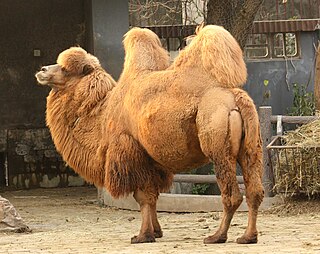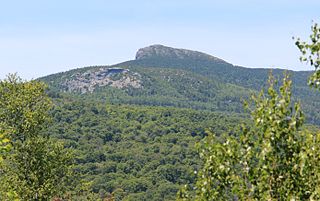
A camel is an even-toed ungulate in the genus Camelus that bears distinctive fatty deposits known as "humps" on its back. Camels have long been domesticated and, as livestock, they provide food and textiles. Camels are working animals especially suited to their desert habitat and are a vital means of transport for passengers and cargo. There are three surviving species of camel. The one-humped dromedary makes up 94% of the world's camel population, and the two-humped Bactrian camel makes up 6%. The Wild Bactrian camel is a separate species and is now critically endangered.

The dromedary, also called the Arabian camel, is a large, even-toed ungulate with one hump on its back. It is the tallest of the three species of camel; adult males stand 1.8–2 m (5.9–6.6 ft) at the shoulder, while females are 1.7–1.9 m (5.6–6.2 ft) tall. Males typically weigh between 400 and 600 kg, and females weigh between 300 and 540 kg. The species' distinctive features include its long, curved neck, narrow chest, a single hump, and long hairs on the throat, shoulders and hump. The coat is generally a shade of brown. The hump, 20 cm (7.9 in) tall or more, is made of fat bound together by fibrous tissue.

Just So Stories for Little Children is a 1902 collection of origin stories by the British author Rudyard Kipling. Considered a classic of children's literature, the book is among Kipling's best known works.

The Bactrian camel is a large, even-toed ungulate native to the steppes of Central Asia. It has two humps on its back, in contrast to the single-humped dromedary camel. Its population of two million exists mainly in the domesticated form. Their name comes from the ancient historical region of Bactria.
A cama is a hybrid between a male dromedary camel and a female llama, and has been produced via artificial insemination at the Camel Reproduction Centre in Dubai. The first cama was born on January 14, 1998. The aim was to create an animal capable of higher wool production than the llama, with the size and strength of a camel and a cooperative temperament.

Mount Ellen is a mountain in the Green Mountains in the U.S. state of Vermont. Located at the northern edge of the Green Mountain National Forest in Washington County, the summit of Mount Ellen is in the town of Warren but the mountain extends into Fayston to the north. Together with Lincoln Peak to the south, the slopes of Mount Ellen are home to the Sugarbush Resort.

Camel's Hump is a mountain in the Green Mountains in the U.S. state of Vermont. The north slope of the mountain borders the Winooski River, which has carved through the Green Mountains over eons. At 4,083 feet (1,244 m), it is tied for the third-highest mountain in Vermont. Surrounded by 10 acres (4 ha) of alpine tundra, the mountain is the most significant feature in Camel's Hump State Park. Because of its distinctive profile, it is perhaps the state's most recognized mountain, featured on the state quarter.

Camelops is an extinct genus of camels that lived in Western North America, ranging from Alaska to Mexico, from the middle Pliocene to the end of the Pleistocene. It shares a common ancestor with the Old World dromedary and Bactrian camel, as well as a more distant common ancestor with the New World alpaca, guanaco, llama, and vicuña. Its name is derived from the Ancient Greek κάμελος and ὄψ, i.e. "camel-face".
Hump, The Hump, or humping may refer to:
Sopwith Camel was an American rock band associated with the San Francisco psychedelic rock scene of the mid 1960s.

Mount Macedon is a mountain that is part of the Macedon Ranges of the Great Dividing Range, located in the Central Highlands region of Victoria, Australia. The mountain has an elevation of 1,001 metres (3,284 ft) with a prominence of 643 metres (2,110 ft) and is located approximately 65 kilometres (40 mi) northwest of Melbourne.

The Campbell Fighting Camels and Campbell Lady Camels represent Campbell University and are the nicknames of the school's 19 teams that compete at the Division I level of the NCAA.
A hybrid camel is a hybrid between a Bactrian camel and dromedary.

Camel's Hump State Park is a state park in the U.S. state of Vermont. The park straddles the northern Green Mountains in an area bounded by Vermont Route 17 on the south and the Winooski River on the north. As of 2017, the park covered a total of 21,224 acres (8,589 ha), making it the largest state park in Vermont.

The wild Bactrian camel is a critically endangered species of camel living in parts of northern China and southern Mongolia. It is closely related to the Bactrian camel. Both are large, double-humped even-toed ungulates native to the steppes of central Asia. Until recently, wild Bactrian camels were thought to have descended from domesticated Bactrian camels that became feral after being released into the wild. However, genetic studies have established it as a separate species which diverged from the Bactrian camel about 1.1 million years ago.

Chris Sullivan is an American actor and musician. He currently stars as Toby on the NBC drama This Is Us. For this role, Sullivan was nominated for the Primetime Emmy Award for Outstanding Supporting Actor in a Drama Series in 2019.

Camel's Hump State Forest covers a total of 2,323 acres (9.40 km2) in two blocks in the U.S. state of Vermont. Stevens Block comprises 1,680 acres (6.8 km2) in Buels Gore, Fayston, and Starksboro in Chittenden, Washington, and Addison counties, respectively. Howe Block covers 643 acres (2.60 km2) in Waitsfield and Fayston, both in Washington county. The forest is managed by the Vermont Department of Forests, Parks and Recreation.

Vavul Mala is a peak in the Western Ghats in the Vellarimala range of Kerala, India. It is situated at the border of Malappuram district and Kozhikode district in Kerala. Vavulmala resembles to a "Camel Hump". Situated at a height of 2,339m, it is the highest peak in the Western Ghats northwards beyond the Nilgiris and also the highest point of Kozhikode district.These compact hills are faunatically and floristically similar to Nilgiri hills.
Camel's Hump Forest Reserve is a protected area in the U.S. state of Vermont. The area is bounded by Vermont Route 17 on the south, the Winooski River on the north, the Mad River on the east, and the Huntington River on the west. The Forest Reserve covers a total of 127.68 square miles (330.7 km2) or 81,715 acres (33,069 ha) of both public and privately-owned land, one of the largest blocks of core forest in the state.

Camel's Hump Natural Area is a protected area in the U.S. state of Vermont. The natural area straddles the ridge of the Green Mountains in Chittenden and Washington counties, in the towns of Duxbury, Huntington, Fayston, Bolton, and Buels Gore. The natural area is administered by the Vermont Department of Forests, Parks and Recreation.
















